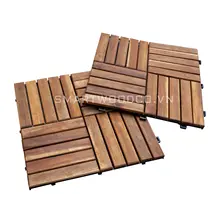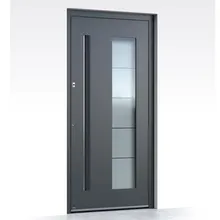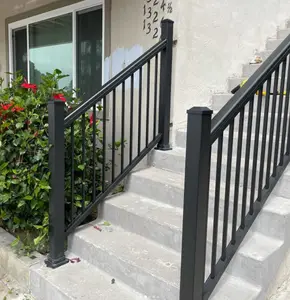Introduction
Navigating the world of outdoor stair rails can be a daunting task, given the myriad of options available. These essential components not only ensure safety and support but also contribute significantly to the aesthetic appeal of your property. This comprehensive guide will walk you through the importance of outdoor stair rails, factors to consider when choosing them, the variety of material options, design and aesthetic considerations, safety guidelines, and tips on installation and maintenance. Whether you're a homeowner looking to enhance your property's exterior or a professional seeking insights, this guide offers valuable information to help you make an informed decision.
Understanding the Importance of Outdoor Stair Rails
Handrails are a crucial component of outdoor steps, offering safety and support to users of all ages and abilities. They assist in preventing accidents and injuries by providing a grip during falls or slips. Handrails are particularly beneficial during extreme weather conditions when steps can become slippery. They also enhance the overall aesthetic of a property, coming in various materials, colors, styles, and designs to complement the property's exterior.
Factors to Consider When Choosing Outdoor Stair Rails
An outdoor handrail serves multiple purposes, enhancing your property's appearance and providing a practical grip for safety. When choosing an outdoor handrail, thoughtful, researched choices deliver the best results. Factors to consider include your taste, budget, and functional needs. Outdoor handrails aren’t just for looks. They can help prevent a potentially nasty fall, making it worthwhile to invest time in finding the right one.
Material Options for Outdoor Stair Rails
Outdoor stair rails come in a variety of materials, each offering unique advantages. Aluminum rails are lightweight yet sturdy, and resist rust. Vinyl and PVC options are low-maintenance and water-resistant. Polyurethane rails are durable and can withstand extreme weather conditions. Wood, a classic choice, offers a warm, natural aesthetic. Metal handrails, including those made from steel or iron, are strong and can be crafted into intricate designs. Rubber handrails provide a comfortable grip and are slip-resistant. Lastly, cedar rails, a type of wood, are known for their natural resistance to decay and insects.
Wooden Stair Rails
Wooden staircase railings are known for their beauty and charm, lending a natural and airy feel to your home. They are easily molded into unique designs, complementing your house's aesthetics. Wood railings are easy to clean and make minimal noise. However, they can be slippery when wet and are prone to rotting due to water and humidity. Installation and repair can be challenging and expensive.
Metal Stair Rails
Metal stair railings are a popular choice for outdoor use due to their durability and resilience. They are available in various types such as wrought iron, stainless steel, aluminum, brass, and copper. These materials are resistant to corrosion, rust, chipping, and peeling, making them a more low-maintenance option compared to wood. Whether you prefer intricate designs with curves or simple elegance, metal stair railings can enhance the aesthetic appeal of your home's exterior.
Glass Stair Rails
Glass stair rails, often used in balustrades, provide a modern aesthetic to any property. They allow a large amount of natural light in, enhancing visibility and reducing the need for artificial lighting. Made from toughened glass, they are safe and unlikely to shatter or break. However, they may require more cleaning to maintain their best condition. Also, depending on the materials paired with the glass, they may produce 'cold' colours in the room, potentially making the stairway seem colder.
Composite Stair Rails
Composite stair rails are becoming increasingly popular due to their durability, low maintenance, and high value for cost. They offer enduring beauty with greater fade and stain resistance than wood, and long-lasting structural integrity due to their high-performance material composition. They require no sanding, staining, or sealing for protection, and offer stylish customization options. They outperform traditional wood in terms of durability and aesthetics, requiring minimal maintenance, saving time and money.
Design and Aesthetic Considerations
Outdoor stair railings can be a significant design statement for your space. They allow you to showcase your personal style and give a completed look and feel to your outdoor living area. For instance, a sleek black aluminum railing delivers a chic, minimalist feel, while a white composite railing gives a uniquely modern look. If you prefer a minimalist look with unobstructed views, consider glass panel infills. The choice of railing can transform your stairs into an elegant transition point from deck to patio, adding to the overall aesthetic appeal of your home.
Safety Considerations
Safety is paramount when it comes to outdoor stair rails. Rails should be between 34 and 38 inches high, with a minimum hand clearance from the wall of 1.5 inches for easy grasping. Guardrails must withstand 200 pounds of force without excessive deflection. Balusters should be 4 inches apart or less to prevent small children from slipping through. Always adhere to local building codes and standards, including the International Residential Code (IRC) and the International Building Code (IBC).
Installation and Maintenance
Installing outdoor stair rails can be a DIY project or done by professionals. The process involves measuring and cutting the rail to fit your steps, ensuring it's level, and securely fastening it to the steps. It's crucial to plumb, cut, and fit your rail to the steps before inserting post mount brackets. Once the rail is sitting plumb, remove it from the steps, locate the post mount brackets, and install them. The success of your installation is dependent on the quality of your stair material and the type and quality of the fastener you use. If unsure, it's recommended to contact a reputable contractor.
DIY Installation
DIY installation of outdoor stair rails can be a rewarding task. Start by fitting your rail to the steps before inserting post mount brackets. Adjust the rail to your desired position, ensuring it's plumb. If the rail sets out of plumb, trim one post to fit your steps. Once the rail is sitting plumb, remove it from the steps and insert the post mount brackets. Finally, drill a hole through the post mount into your steps and use an anchor suitable for your step materials to fasten the rail. Remember, the success of your installation is dependent on the quality of your stair material and the type and quality of the fastener you use.
Professional Installation
Professional installation of outdoor stair rails is a wise choice, especially considering safety. The cost of labor averages around $30 per foot. Contractors may charge hourly rates, typically between $60 to $200 per hour. It's crucial to ensure the railing is anchored properly to prevent potential injuries. Also, be aware of local stair rail codes, as they have specific requirements for railing height, baluster spacing, and the gap between the bottom rail and the top of each step.
Maintenance Tips
Maintaining outdoor stair rails is crucial for safety and aesthetics. Regularly inspect for signs of damage, such as loose treads or cracks. Check the railing for rust or paint flaking, especially in areas exposed to the elements. Handrails should be firmly attached, and any holes in metal stairs should be monitored for rust. Inspect the stairs from below for unseen damage. Consider waterproofing your staircase to extend its life and prevent water damage.
Conclusion
Choosing the perfect outdoor stair rails involves a careful balance of aesthetics, safety, and functionality. From understanding the importance of handrails to exploring various material options and design considerations, it's clear that a well-chosen stair rail can significantly enhance your property's appeal and safety. Remember, safety should never be compromised, and adherence to local building codes is paramount. Whether you opt for a DIY installation or hire a professional, regular maintenance is crucial to ensure the longevity and performance of your outdoor stair rails. With this comprehensive guide, you're now equipped to make an informed decision that suits your taste, budget, and functional needs.










































 浙公网安备 33010002000092号
浙公网安备 33010002000092号 浙B2-20120091-4
浙B2-20120091-4